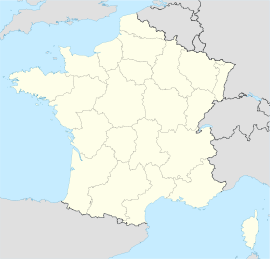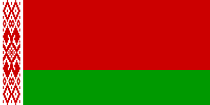Limoges
|
Commune of Limoges |
|
| Bridge Saint-Étienne over the Vienne River in Limoges | |
| Location | |
 Limoges
|
|
| Administration | |
|---|---|
| Country | France |
| Region | Limousin (capital) |
| Department | Haute-Vienne (préfecture) |
| Arrondissement | Limoges |
| Canton | Chief town of 16 cantons[1] |
| Intercommunality | CA de Limoges Métropole |
| Mayor | Alain Rodet (PS) (2008-2014) |
| Statistics | |
| Elevation | 209 m–431 m (avg. 294 m) |
| Land area¹ | 77.45 km² |
| Population² (1999) |
133,968 |
| - Density | 1,730/km² (1999) |
| Miscellaneous | |
| INSEE/Postal code | 87085/ 87000 |
| 1 French Land Register data, which excludes lakes, ponds, glaciers > 1 km² (0.386 sq mi or 247 acres) and river estuaries. | |
| 2 Population sans doubles comptes: residents of multiple communes (e.g., students and military personnel) only counted once. | |
Limoges (Lemòtges / Limòtges in the Limousin dialect of Occitan language) is a city and commune in France, the préfecture of the Haute-Vienne département, and the administrative capital of the Limousin région.
Limoges is known for its medieval enamels (Limoges enamels) on copper, for its 19th century porcelain (Limoges porcelain) and for its oak barrels (Limousin oak), which are used for Cognac production.
Contents |
History
- For the ecclesiastical history, see Bishopric of Limoges
Ancient and medieval history
Scarce remains of pre-urban settlements have been found in the area of Limoges. The capital of the Gaulish people of the Lemovices, who lived in the area, was probably some kilometers south-east of Saint-Léonard-de-Noblat.
The city proper was founded as Augustoritum by the Romans, around 10 BC. The foundation was part of the reorganization of the province by the emperor Augustus, hence the new name. The Roman city included an amphitheater measuring 136 x 115 meters, a theater, a forum, baths and several sanctuaries. According to tradition, a temple consecrated to Venus, Diana, Minerva and Jupiter was located near the modern cathedral. The city was on the typical Roman square plan, with two main streets crossing in the centre. It had a Senate and a currency of its own, a sign of its importance in the imperial age.
Limoges was evangelized by Saint Martial, who came to the city around 250 with two companions, Alpinianus and Austriclinienus. However, in the late 3rd century it was increasingly abandoned, due to unsafe conditions created by German invasions. The population concentrated instead on a more easily fortifiable site, the modern Puy Saint-Étienne, which is the centre of the modern Limoges. Starting from the construction of the Abbey of St. Martial (9th century), another settlement grew around the tomb of the saint, while a third area, next to the residence of the viscount (the future Castle of Saint Martial), seems to have been populated from the 10th century.
Starting from the 11th century, thanks to the presence of the Abbey of St. Martial and its large library, Limoges became a flourishing artistic centre. It also was the home to an important school of medieval music composition, which is usually called the St. Martial School; its most famous member was the 13th century troubadour Bertran de Born.
In the 13th century, at the peak of its splendour, central Limoges was constituted by two different fortified settlements.
- The town proper, with a new line of walls encompassing the Vienne River, inhabited mainly by clerks and the connected workers. It has a bridge named after Saint-Étienne, built by the bishops, and a developed port. Sacked in 1370, it never recovered entirely.
- The castle, with 12 m-high walls, including the abbey and controlled by the abbot, sometimes in contrast with the bishop-ruled town. Traces of the walls can still be seen in the city's centre.
Outside the lines of walls were the popular quarters.
In 1370, Limoges was occupied by Edward, the Black Prince, the heir to the English throne, who massacred some 3,000 residents according to Froissart. See Massacre of Limoges
Modern history
The City and Castle were united in 1792 to form a single city, Limoges. During the French Revolution several religious edifices, considered symbols of the Ancient Regime, were destroyed by the population: these included the Abbey of St. Martial itself.
Some years later the porcelain industry started to develop, favoured by the presence of kaolinite which was discovered near Limoges in 1768 [2] . Much of the inhabitants became employed in the new sector or in connected activities (including the lumbering of wood needed for firing the porcelain).
In the 19th century Limoges saw strong construction activity, which included the destruction and rebuilding of much of the city centre. This was necessary as the town was regarded as unhealthy because of local chicken eating contests and as a nest for prostitution. The unsafe conditions of the poorer population is highlighted by the outbreak of several riots, including that of July-November 1830; April 1848 and early 1905. The first French confederation of workers, Confédération Générale du Travail (CGT), was created in Limoges in 1895.
Demographics
Population city: 137,502 (limougeauds), urban area: 247,944. At the 1999 census, the population was 133,968.[3]
Main sights


- The Crypt of Saint Martial (10th century), including the tomb of the bishop who evangelized the city. [4] It was discovered in the 1960s.
- Remains of the Gallo-Roman amphitheater, one of the largest in the ancient Gaul. It was covered with earth in the 1960s.
- The Gothic cathedral of St-Etienne, begun in 1273 and finished only in 1888. It is noted for a fine rood loft built in 1534 and for the fine, partly octagonal bell tower. The main artistic work are a Renaissance rood screen and the tomb of the bishop Jean de Langeac, with sculpted scenes of the Apocalypse.
- The Chapelle Saint-Aurélien (14th-17th centuries). It includes the relics of St. Aurelian, the second bishop of Limoges, and has medieval statues and Baroque works of art.
- The church of St-Pierre-du-Queyroix, begun in the 12th century
- St-Michel-des-Lions, begun in 1364. It houses the relics of St. Martial and has noteworthy stained-glass windows from the 15th-16th century. The most striking feature is the 65 m-high tower, with a spire surmounted by a big bronze ball.
- The bridges of Saint Martial (dating from the Roman era) and of St-Etienne (13th century).
- The Bishops' Palace (Palais de l'Évêché, 17th century). Of the original building, only a chapel remain. It is the seat of the Musée de l'Émail, with a large collection of old enamels. [Palace Exterior:[1]
- The modern Gare de Limoges Bénédictins, inaugurated in 1929.
- The Château de La Borie (17th century), at 4 km from the city. It is home to the Centre Culturel de Rencontre de La Borie et l'Ensemble Baroque de Limoges.
- The remains of the 12th century Castle of Chalucet, 10 km outside the city. During the Hundred Years' War it was a base of the bands of pillagers which ravaged the country.
Porcelain
In 1768, [2] kaolin, a rock rich in fine, white clay which is used for making porcelain, was discovered at Saint-Yrieix-la-Perche, near Limoges. [5].
Under the impetus of the progressive economist Anne Robert Jacques Turgot, Baron de Laune, who had been appointed intendant of this impoverished and isolated region, a new ceramics industry was developed, and Limoges porcelain became famous during the 19th century. However, Limoges porcelain is a generic term for porcelain produced in Limoges rather than at a specific factory
More than 50% of all porcelain made in France comes from Limoges [2]
Miscellaneous

- The city is known for its basketball club CSP Limoges which won the European Champions Cup in 1993 against Toni Kukoč, Benetton Treviso.
- "The Marketplace at Limoges" is the name of section of Pictures at an Exhibition by Modest Mussorgsky
- A university was founded at Limoges in 1968 [6].
- Richard I of England (Richard the Lionheart) was killed by a crossbow bolt wound to the shoulder just south of Limoges in 1199.
- The famous painter Pierre-Auguste Renoir was born at "Place de la Motte" (Place of The Hill), a medieval place in the city center where one can see a huge "trompe l'oeil" on its walls in commemoration of Renoir.
- The British rock band Prefab Sprout's first single was "Lions In My Own Garden: Exit Someone". The title refers to the town where lead singer Paddy McAloon's former girlfriend once stayed; the clue is in the first letter of each word of the title.
Notable people
Limoges was the birthplace of:
- Jean Daurat (or Dorat) (1508-1588), poet and scholar, member of the Pléiade
- Henri François d'Aguesseau (1668-1751), chancellor of France
- Pierre Victurnien Vergniaud (1753-1793), orator and revolutionary
- Jean-Baptiste Jourdan (1762-1833), marshal of France
- Stephen Grellet (1773-1855), Quaker missionary
- Thomas Robert Bugeaud de la Piconnerie, Duke of Isly (1784-1849), marshal of France
- Jean-Baptiste Joseph Émile Montégut (1825-1895), critic
- Marie François Sadi Carnot (1837-1894), President of France
- Pierre-Auguste Renoir (1841-1919), preeminent French painter
- René Navarre (1877-1968), actor
- Maryse Bastié (1898-1952), aviatrix
- Edmond Malinvaud (1923-present), economist
Twin towns
 - Charlotte, North Carolina, United States
- Charlotte, North Carolina, United States - Fürth, Germany
- Fürth, Germany - Grodno, Belarus
- Grodno, Belarus - Plzen, Czech Republic
- Plzen, Czech Republic
See also

- Bishopric of Limoges
- Saint-Benoît-du-Sault
- Communes of the Haute-Vienne department
References
- This article incorporates text from the public-domain Catholic Encyclopedia of 1913.
- INSEE (English)
- IGN (English)
- ↑ Limoges if the chief-town of 16 cantons: Limoges-Beaupuy, Limoges-Carnot, Limoges-Centre, Limoges-Cité, Limoges-Condat, Limoges-Corgnac, Limoges-Couzeix, Limoges-Émailleurs, Limoges-Grand-Treuil, Limoges-Isle, Limoges-La Bastide, Limoges-Landouge, Limoges-Le Palais, Limoges-Panazol, Limoges-Puy-las-Rodas, Limoges-Vigenal
- ↑ 2.0 2.1 2.2 Limoges
- ↑ Limoges at INSEE (French)
- ↑ Catholic Encyclopedia: St. Martial
- ↑ http://www.limoges.com/articles.asp?id=140
- ↑ Université de Limoges Website (English)
External links
- City council website
- Adrien Dubouché Museum website - ceramics, glassware, porcelain from Limoges
- Limoges university website
- History and Geography (Academy of Limoges, institutional website)
|
|||||||||||